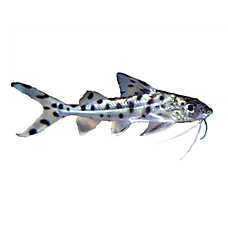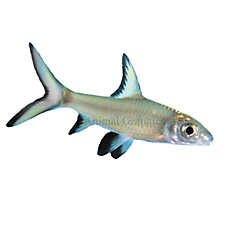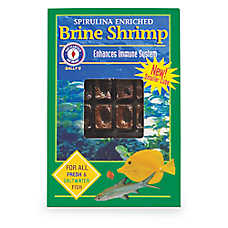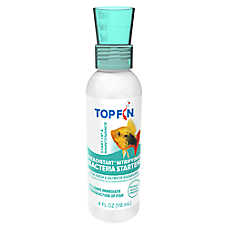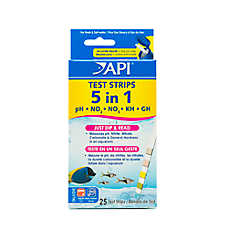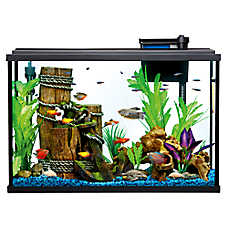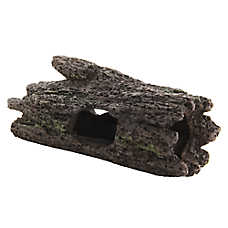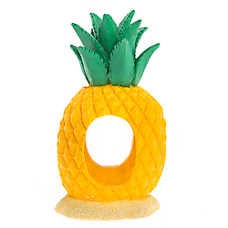Semi-Aggressive Fish Care Guide
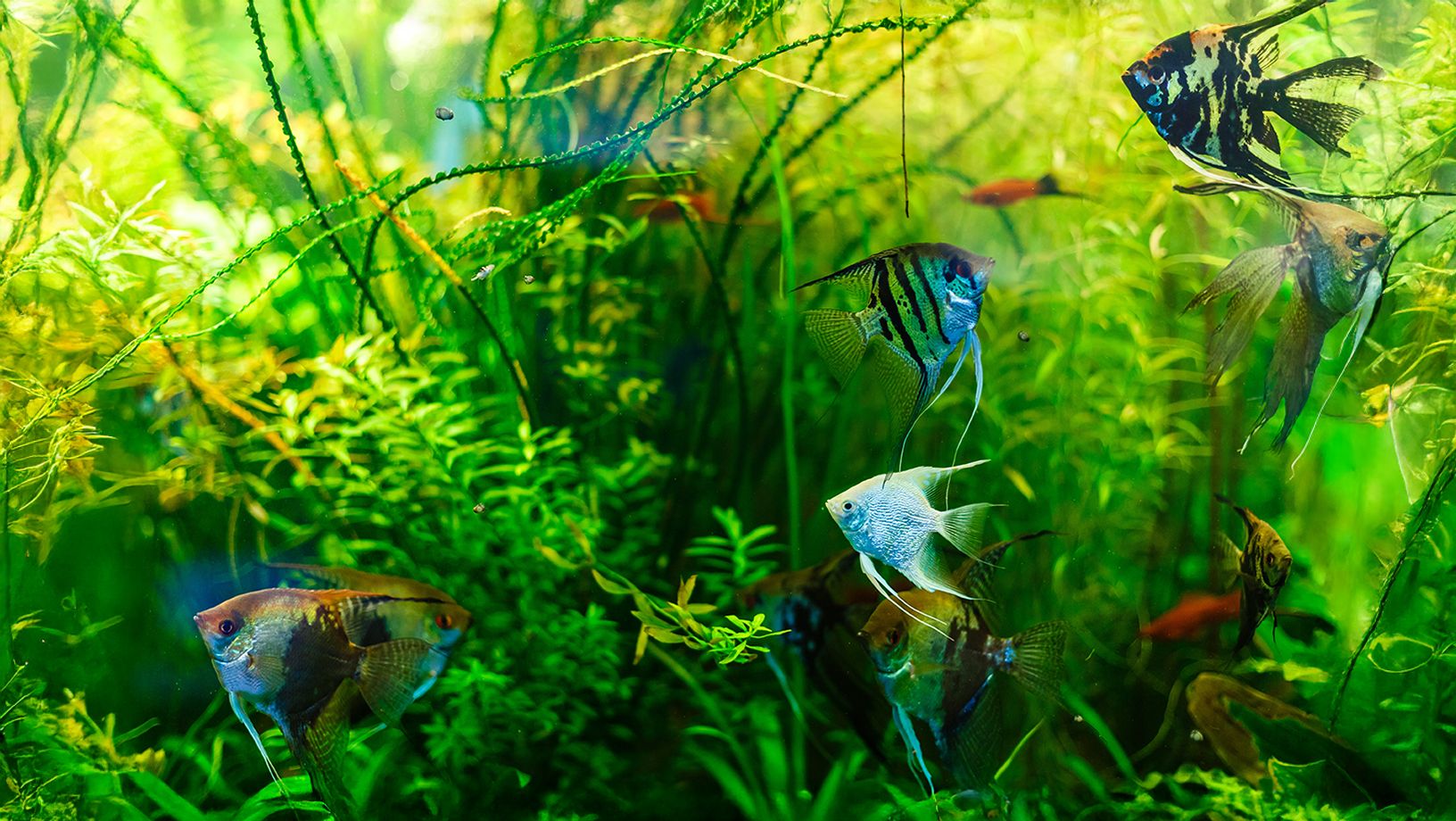
In this Article
Bold and Boisterous
As the name suggests, these fish are generally peaceful and calm, but can be territorial or boisterous. These fish tend to have a lot of personality and have interesting interactions between fish. Semi-aggressive fish include a wide variety of species that can coexist with others - with the right planning and monitoring. They’re known for their bold personalities and fascinating behaviors, making these fish a lot of fun to watch and keep as pets!
Behavior: Semi-aggressive fish are more likely to claim territory, exhibit pushy behavior, or nip at slower tank mates. While some do well in groups, others do best as single specimen within your larger community of fish.
When keeping fish as pets, there are no guarantees that the fish will get along. You should always monitor your fish for signs of stress or aggression and be prepared to relocate the fish from the aquarium. Not sure which species get along? Our Fish Compatibility Guide can help you choose compatible tank mates.
It can also be helpful to rearrange or add decor to create additional territories and hiding places. Live plants help maintain water quality and provide hiding places for fish. Often, the more plants and décor, the more you see your fish! A tank with lots of variety in plants and décor is more interesting and less stressful for your fish, a bit like offering new toys or beds to your dog or cat!
Category information tables
Each of these is broken into a table with a representative image. For Gourami, that image is now a Canada exclusive offering. A Honey Gourami may be a better choice since the US offers that species and Canada offers a red variant.
Angelfish
SIZE: Up to 6" tall
LIFESPAN: 8-12 years, potentially longer in ideal conditions
EXAMPLES: Glo Angelfish (Pterophyllum scalare), Black Angelfish(Pterophyllum scalare), Veil Angelfish (Pterophyllum scalare)
TANK SIZE: 50+ gallon
WATER TEMP: 76-86° F (24-30° C)
HABITAT: Natural gravel and a few ornaments/rocks. Lots of live plants are preferred.
BEHAVIOR: Semi-Aggressive.
SCHOOLING: They will do well individually or in groups of 2 to 4. Monitor groups for aggression.
COMMUNITY: Angelfish do well with most community fish and many semi-aggressive fish. They prefer a tall, heavily planted tank.
NATURAL DIET: Insects and crustaceans.
FOOD: High quality tropical fish flakes and frozen fish food occasionally
Barbs
SIZE: Up to 3"
LIFESPAN: 4-7 years, potentially longer in ideal conditions
EXAMPLES: Tiger Barbs (Puntigrus tetrazona), Cherry Barbs (Puntius titteya), Gold Barb (Barbodes semifasciolatus)
TANK SIZE: 10+ gallon
WATER TEMP: 68-79° F (20-26° C)
HABITAT: Natural gravel and a few ornaments/rocks. Lots of live plants are preferred.
BEHAVIOR: Semi-Aggressive
SCHOOLING: Yes, they typically prefer groups of 5 or more. Monitor for signs of aggression.
COMMUNITY: Barbs can often coexist peacefully with many community fish but can be boisterous and may fin nip if stressed or lacking enrichment.
NATURAL DIET: Small insects and crustaceans.
FOOD: High quality tropical fish flakes and frozen fish food occasionally
Dwarf Cichlids
SIZE: Up to 3”
LIFESPAN: 2-3 years, potentially longer in ideal conditions
EXAMPLES: Balloon Belly Ram (Mikrogeophagus ramirezi)
TANK SIZE: 10+ gallon
WATER TEMP: 81-86° F (27-30° C)
HABITAT: Natural gravel and a few ornaments/rocks. Lots of live plants are preferred.
BEHAVIOR: Semi-Aggressive.
SCHOOLING: They will do well in groups of 2 to 4. Monitor groups for aggression.
COMMUNITY: Dwarf cichlids do well with most community fish. Many semi-aggressive fish are more boisterous or territorial than Balloon Belly Rams so use caution with semi-aggressive fish.
NATURAL DIET: Insects and small crustaceans.
FOOD: High quality tropical fish flakes and frozen fish food occasionally
Gourami
SIZE: Up to 6"
LIFESPAN: 3-5 years, potentially longer in ideal conditions
EXAMPLES: Honey Gourami, Dwarf Gourami, Blue Gourami
TANK: 10+ gallon for Dwarf and Honey Gourami, 29+ for Blue Gourami
WATER TEMP: 75-80° F (24-26° C)
HABITAT: Natural gravel or sand, a few large ornaments/rocks, and live plants.
BEHAVIOR: Semi-Aggressive
SCHOOLING: No. They may get along, but males can occasionally be aggressive towards others of the same species.
COMMUNITY: This group looks stunning in a heavily planted tank and can cohabitate with peaceful fish and often with semi-aggressive fish.
NATURAL DIET: Small insects and crustaceans.
FOOD: High quality tropical fish flakes and frozen fish food occasionally.
Freshwater Sharks
SIZE: Up to 6" for Red-Tailed and Rainbow, 14” for Bala Sharks
LIFESPAN: 4-10 years, potentially longer in ideal conditions
EXAMPLES: Glo Rainbow Sharks (Epalzeorhynchos frenatum), Rainbow Sharks (Epalzeorhynchos frenatum), Bala Sharks (Balantiocheilos melanopterus), Red-Tailed Sharks (Epalzeorhynchos bicolor)
TANK SIZE: 50+ gallon
WATER TEMP: 68-80° F (20-26° C)
HABITAT: Natural gravel and a few ornaments/rocks.
BEHAVIOR: Semi-Aggressive
SCHOOLING: Rainbow Sharks do best kept individually as they can be highly territorial. Bala Sharks, however, prefer to be in groups of 5 or more.
COMMUNITY: Rainbow Sharks are boisterous and territorial, doing best with large semi-aggressive fish. Avoid similar looking fish such as loaches, botias, and Chinese Algae Eaters. Bala Sharks prefer to be in schools but may chase or prey on smaller fish.
NATURAL DIET: Small insects and crustaceans.
FOOD: High quality tropical fish flakes and frozen fish food occasionally
Large Bichir
SIZE: Up to 24"
LIFESPAN: 10-15 years, potentially longer in ideal conditions
EXAMPLES: Dinosaur Bichir (Polypterus senegalus)
TANK SIZE: 125+ gallon
WATER TEMP: 75-82° F (24-28° C)
HABITAT: Natural gravel and a few ornaments/rocks.
BEHAVIOR: Semi-Aggressive.
SCHOOLING: They will do well as a single bichir in the aquarium.
COMMUNITY: Bichirs do well with peaceful or semi-aggressive fish too large to fit in their mouths.
NATURAL DIET: Insects, crustaceans, small fish.
FOOD: High quality tropical fish flakes as a juvenile then pellets as an adult. Frozen fish food occasionally
Loaches & Botias
SIZE: Up to 12" for clown loaches, 4-6” for the others
LIFESPAN: 6-10 years, potentially longer in ideal conditions
EXAMPLES: Clown Loach (Chromobotia macracanthus), Kuhli Loach (Pangio oblonga), Yo-Yo Botia (Botia almorhae)
TANK SIZE: 20+ gallon
WATER TEMP: 76-80° F (25-26° C)
HABITAT: Natural sand and a few ornaments/rocks. Lots of live plants are preferred.
BEHAVIOR: Semi-Aggressive.
SCHOOLING: Loaches and botias prefer large schools of 12 or more.
COMMUNITY: Loaches and botias do well with most community fish and many semi-aggressive fish. They prefer a sand tank to allow them to dig and may prey on snails.
NATURAL DIET: Insects and crustaceans.
FOOD: High quality sinking pellets and frozen fish food occasionally
Semi-Aggressive Algae Eater
SIZE: Up to 11"
LIFESPAN: 8-10 years, potentially longer in ideal conditions
EXAMPLES: Chinese Algae Eater (Gyrinocheilus aymonieri)
TANK SIZE: 50+ gallon
WATER TEMP: 72-79° F (22-26° C)
HABITAT: Natural gravel and a few ornaments/rocks.
BEHAVIOR: Semi-Aggressive
SCHOOLING: These fish do well as an individual specimen in a semi-aggressive aquarium or with large community fish. They do not tolerate smaller, similar looking fish such as loaches, freshwater sharks, or other algae eaters. In a large enough aquarium, groups of 6 or more can show fascinating community behaviors.
COMMUNITY: Will do well in a large semi-aggressive aquarium or in a large community aquarium with similarly sized fish.
NATURAL DIET: Algae, small crustaceans, and insect larvae
FOOD: Available algae, appropriately sized sinking vegetable-based pellets, and blanched vegetables (broccoli, cucumber, zucchini, and leafy greens).
Rainbowfish
SIZE: 4"
LIFESPAN: 5-8 years, potentially longer in ideal conditions
EXAMPLES: Boesemani Rainbowfish (Melanotaenia boesemani), Australian Rainbowfish (Melanotaenia fluviatilis), Turquoise Rainbowfish (Melanotaenia lacustris)
TANK SIZE: 29+ gallon
WATER TEMP: 75-82° F (24-28° C)
HABITAT: Natural gravel or sand and a few ornaments/rocks. Lots of live plants are preferred.
BEHAVIOR: Semi-Aggressive.
SCHOOLING: Yes, groups of 6 or more preferred.
COMMUNITY: Rainbowfish do well with most community fish and some semi-aggressive fish. They prefer heavily planted tank with calm tank mates.
NATURAL DIET: Insects and crustaceans.
FOOD: High quality tropical fish flakes and frozen fish food occasionally
Section 3 Title: How do I set up a semi-aggressive fish aquarium?
Typical Community Fish Aquarium:
- Glass or acrylic tank
- Hood or tank cover with light
- Thermometer
- Substrate: Gravel or sand
- Décor for hiding and enrichment
- Live or artificial plants
- Heater
- Filter
Setup Steps:
- Choose your equipment: Select an appropriately sized tank, substrate, décor, heater, and filter. A PetSmart associate can help guide your selections.
- Prepare your space: Place the aquarium on a flat, stable surface that can support its full weight - water weighs 8.3 pounds per gallon.
- Rinse and place décor: Rinse all substrate and decorations with tap water (never soap), then add to the tank.
- Add water and conditioner: Fill with tap water and use a water conditioner to remove chlorine and chloramines. If your home uses a water softener, use a tap source that bypasses it.
- Install and test equipment: Set up the heater, filter, and thermometer per manufacturer instructions. Add the hood and lighting and set lights on a 12-hour cycle using a timer for consistency.
- Let the tank stabilize: Run the system for at least 24 hours to ensure all equipment works and the water temperature is stable.
- Begin cycling the tank: Add a beneficial bacteria starter and introduce just a few hardy fish to start, or follow a fishless cycling process to reduce stress.
- Monitor water quality daily: During cycling, test water regularly. Perform a water change if ammonia or nitrite is above 0 ppm or if nitrate exceeds 20 ppm. Always add water conditioner after each change.
- Add fish gradually: Once your tank is cycled and stable, add compatible fish slowly and monitor for any signs of illness or stress.
- See the full Fish Compatibility Guide for detailed information on tank mate choices.
- Quarantine new additions: To protect your established aquarium, quarantine new fish for 30 days in a separate, cycled setup.
Learn more about fish-less cycling in Setting Up an Aquarium.
When should I test my water quality?
- Fish are sluggish, near the bottom of the tank
- Fish are at the top, breaking the water to breathe
- Fish are not eating
- Sudden behavior changes in your fish
- Water is cloudy
- Water smells funny
PetSmart offers free water quality testing and one of our knowledgeable associates can help you get your system balanced.
When should I contact a veterinarian?
Contact an aquatic veterinarian if you notice the following signs:
- Unusual swimming pattern
- Thinness or decreased appetite
- Abdominal swelling
- Inflamed or discolored skin/fins
- Fins clamped to sides of body
- Scraping body on rocks (flashing)
- Visible signs of illness or recent fish loss
If your fish show any of the signs above, we recommend using the “Find a Fish Vet” tool at fishvets.org or wavma.org to locate a qualified aquatic veterinarian in your area.
SHOPPING CHECKLIST
Section 4 Imaging: Keep Vet Assured logo, safety tips, and disclaimers. For digital, remove the Treats reward and delivery option splash panels, keep free water testing either under Ready to Learn More or after shopping list.
What will I need for my semi-aggressive fish?
- Aquarium sized appropriately for the species and number of fish, (10-20+ gallon) with stand
- Aquarium top/hood with light fixture
- Natural aquarium gravel or sand & gravel vacuum
- Tank décor like driftwood or ornaments
- Live or artificial plants
- Aquarium heater and thermometer
- Aquarium filter sized for your tank
- Water testing kit or strips
- Water conditioner/dechlorinator
- Beneficial bacteria starter
- Algae cleaning pad or scraper
- Species-appropriate pellets or flakes and frozen fish food
Ready to learn more?
This guide is a great starting place, but we encourage you to do more research on the individual species that you are keeping so that you can be as successful as possible with your aquarium!
Related guides:
